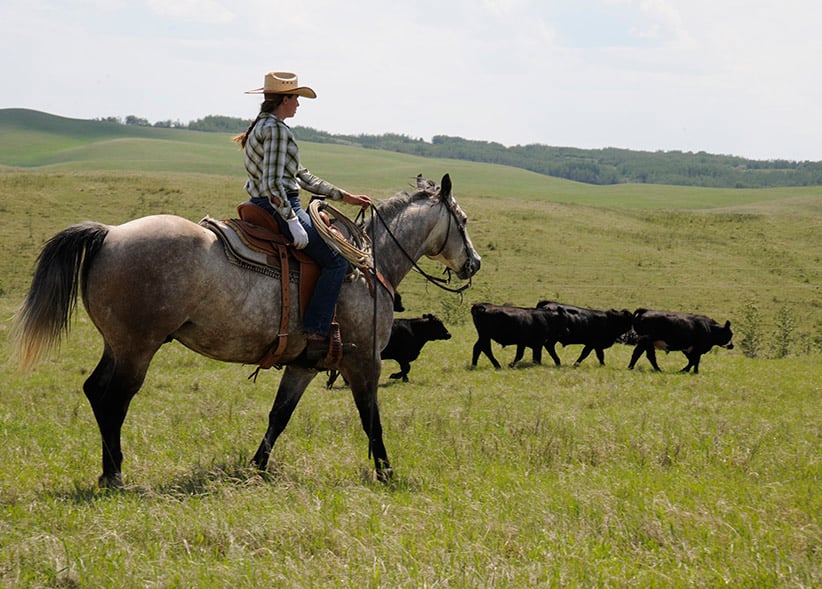Bring your own horse to cowboy college
Students at Lakeland College in Vermilion, Alta., study from the saddle. When they’re done, they find work on ranches, feedlots and remote cow camps.
Cow horse program. (Lakeland College)
Share

There’s just one college course in Canada where you bring your own horse to class, study from a saddle, and where blue jeans and a Stetson are required attire.
Since 2002, students hankering for a job on the range have signed up for Lakeland College’s western ranch and cow horse program. The two-semester program at Lakeland’s Vermilion, Alta., campus prepares students for work as pen riders (sometimes called feedlot cowboys), pasture riders, horse trainers and ranch hands.
As you might expect from a cowboy course, rope burns and hard knocks are part of the curriculum: students occasionally get bucked off their mounts. One component of the 30-week certificate program (tuition is $6,400, books and supplies another $1,000) is training green horses into skilled cow horses. “But this isn’t rodeo riding,” notes program head Ron Hoffman. “We aren’t trying to get on and ride the buck out. We are actually trying to train the horse to become a willing partner in the job, as opposed to forcing the horse to do the job.”
Subjects include roping, riding, cattle handling, equine husbandry, stable management, beef production and how to identify and treat bovine diseases. Most students end up working in Alberta and Saskatchewan at private ranches, feed lots, and collectively operated pastures. The school says the average top wage is $59,000 a year, and that about 94 per cent get jobs after graduation.
In his years as a cowboy instructor, Hoffman has seen more women enter the program to the point where they now represent 70 per cent of the student population. That’s in part because higher-paying oil-patch jobs have drawn many men away from ranch and agricultural work. But women, who tend to have a greater affinity for animals, make great pen riders.
In the end, being a cattleman or cattlewoman is about taking care of animals. While some women are just as strong as the guys, says Hoffman, “If we do our job correctly the horse will do most of the strength-required work.”
Demand for pen and pasture riders has been steady over the years. Art Wheat, a rancher and owner of T-Bone Cattle Co. in Marwayne, Alta., has employed two Lakeland grads as pasture riders for the Tulliby Lake Stockmans Association. That particular job is isolated, seasonal work on a remote federal grazing lease with a large herd of cattle belonging to the association’s ranchers. The two riders live in “cow camp” all summer, sleeping and eating in a rustic cabin with a propane fridge and stove and electricity from a generator. It takes self-reliance and hardiness to live and work that way, says Wheat, adding that the association’s riders earn about $4,500 a month. Feedlot workers, who start at around $15 per hour, work more regular hours and can go home afterwards.
Jesse Rempel, 26, who graduated from the program in 2009, now owns JT Ranch, just west of Hanley, Sask., where he trains horses for rodeo and barrel riders and regular riders who want someone to get their colts and fillies used to the saddle. Growing up on a mixed cattle and grain farm, he only had modest experience riding horses. He brought a two-year-old bay mare named Skip with him to Lakeland’s large, well-equipped riding and training arena in Vermilion.
“It’s a lot of practical learning,” recalls Rempel. “I am not much into studies or reading lots. It’s a lot of hands-on stuff. You go out and you are dealing with the livestock one on one, you’re running the cows through the chute and the instructors are teaching you how to vet them out [for disease].”
During studies, students are expected to dress western style. While you can pass on the plate-sized belt buckles, sweatpants are definitely out, and riding boots, blue jeans, and long-sleeved shirts are part of the uniform. While a baseball cap, helmet, or even a toque is acceptable for riding in cold weather, on exam days, students wear a cowboy hat, lest they find themselves lassoed out of class.